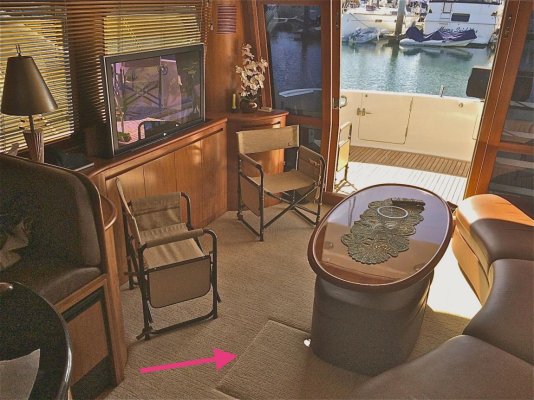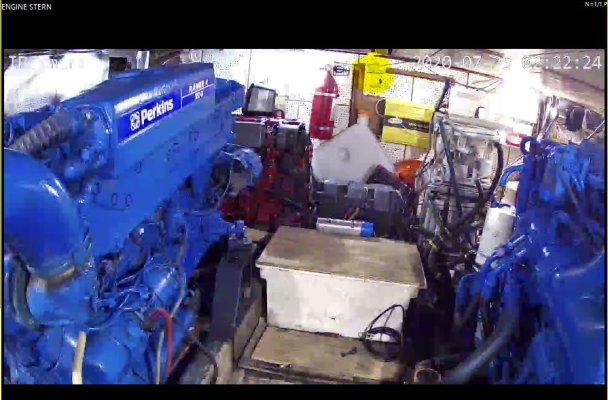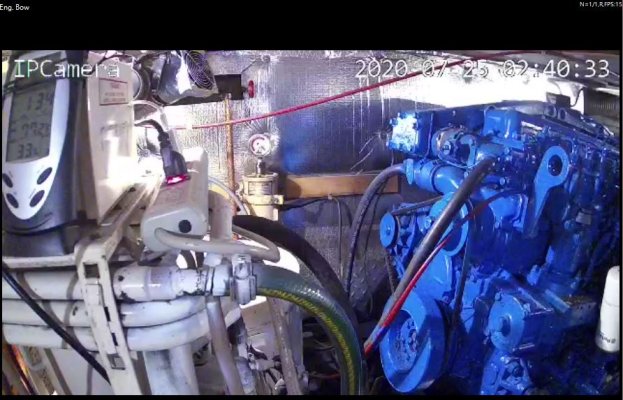The recent thread on ST44 Daily Engine Checks prompted me to create this thread.
The only way to check the oil level in my 165hp turbo diesel engine is via the dipstick. In order to do this, I must take up the carpet and padding in the main salon and raise a very large and heavy engine hatch (that has the dining table permanently bolted to it). A real PITA.
I thought maybe I could find some type of electro-sensor device I could insert in place of the dipstick, such that I could have an oil-level gauge at the helm. So far, I haven't been able to come up with one. Has anyone ever seen anything like this? Or, does anyone have any alternative solution to suggest?
I have ruled out cutting an access hole in the hatch because the construction of the hatch would not allow me to position such a hole in the necessary location.
Thank you, in advance, for your thoughts on this!
Hi, I do not recommend the short-cut. One of the important details of being a seaman is to--just piddle around the bilges—you never know what you’ll find. Let me copy here an article I wrote for Professional Boatbuilder:
THE GENIE IN THE CIGAR BOX
September 15, 2008
Back in Havana in 1945 we were about to finish the construction of our new sailboat, ALFIN. An old seaman by the name of Cucho had found our first boat, the Black Eagle, for us a couple of years before, and let us moor her at his dock, where he watched out for her. He had become a good friend of our family. One Sunday afternoon, while I (age 14) was visiting Cucho’s home, he told me this story about his own youth and his father.
“My father was, as I am, a commercial fisherman. He fished on a sailboat with a small auxiliary engine, the type of boat they call a goleta. We were living in Regla, a town directly across the entrance channel of the port of Havana.
“Our family lived in a small house not far up the hill from the port, from which you could see many landmarks: the National Observatory; La Cabaña, the Spanish fort defending the east side of the harbor’s entrance; and next to it, the Morro Castle, which was right at the entrance to the harbor.
Cucho grew up helping his father in his spare time. When the old man decided to give up the hard life of fishing and retire to a home he owned inland, Cucho left school at the age of 17 to captain his father’s 45-ft Goleta. His family, which included several brothers and sisters, depended on the income from his fishing.
Six months into this operation, Cucho’s father came to see the family on one of his periodic but not-too-frequent visits. Sitting with Cucho on the porch that evening, he asked his boy about the fishing business and the Goleta.
“It’s not going well, Father. I just don’t seem to be able to keep up with things breaking. I’m always having problems with maintenance, and I’m about to give up and sell the boat.”
Cucho clearly remembered that his father jumped up, put his hands on his head, and said to him, “Ay, Cuchito, I am so sorry that I completely forgot to give you my genie.”
“A genie? Father, I’m serious. The boat seems to break down on every trip. That prevents me from fishing, and you want me to get a genie?”
His dad went to a closet in the back of the house and brought Cucho a small cigar box closed up tight, with paper and fibers from a tow-sack glued over it to keep it shut.
“Son,” he said, “inside this box there is a genie--a maintenance genie. My father had him for years, and now you will inherit him from me. Never--remember never, ever--open the box and allow the genie to fly off. Keep him aboard the boat, and just get in the habit of moving him every Sunday. Take the box from where you had it last week, and put it somewhere else on the boat, as far from the previous place as possible. You should know that the genie is a solitary fellow and favors places in the boat that a person can hardly get to. You know: those really out-of-the-way places in the bilge and in the forepeak and under the engine. Promise me that you’ll do this every week, and I can assure you that the genie will take care of the maintenance problems.”
Six months later, on his father’s next visit, Cucho could not wait to talk to him about the fishing, the goleta, and the genie. “Father,” said Cucho, “that genie is fantastic! The boat has had absolutely no problems since you gave him to me. Just last Sunday, while I was moving his box, I discovered a sea-cock that was about to fail and could have sunk the goleta. I’m now moving him twice a week, and you won’t believe the things I’m finding that need repairing. I wouldn’t trade him for a million pesos!”
EL FIN (THE END)
Kiko Villalon, Pine Island, Florida




